- home
- BAKERECIPES
BakeRecipes
Bringing real baking into your home with deliciously simple recipes.
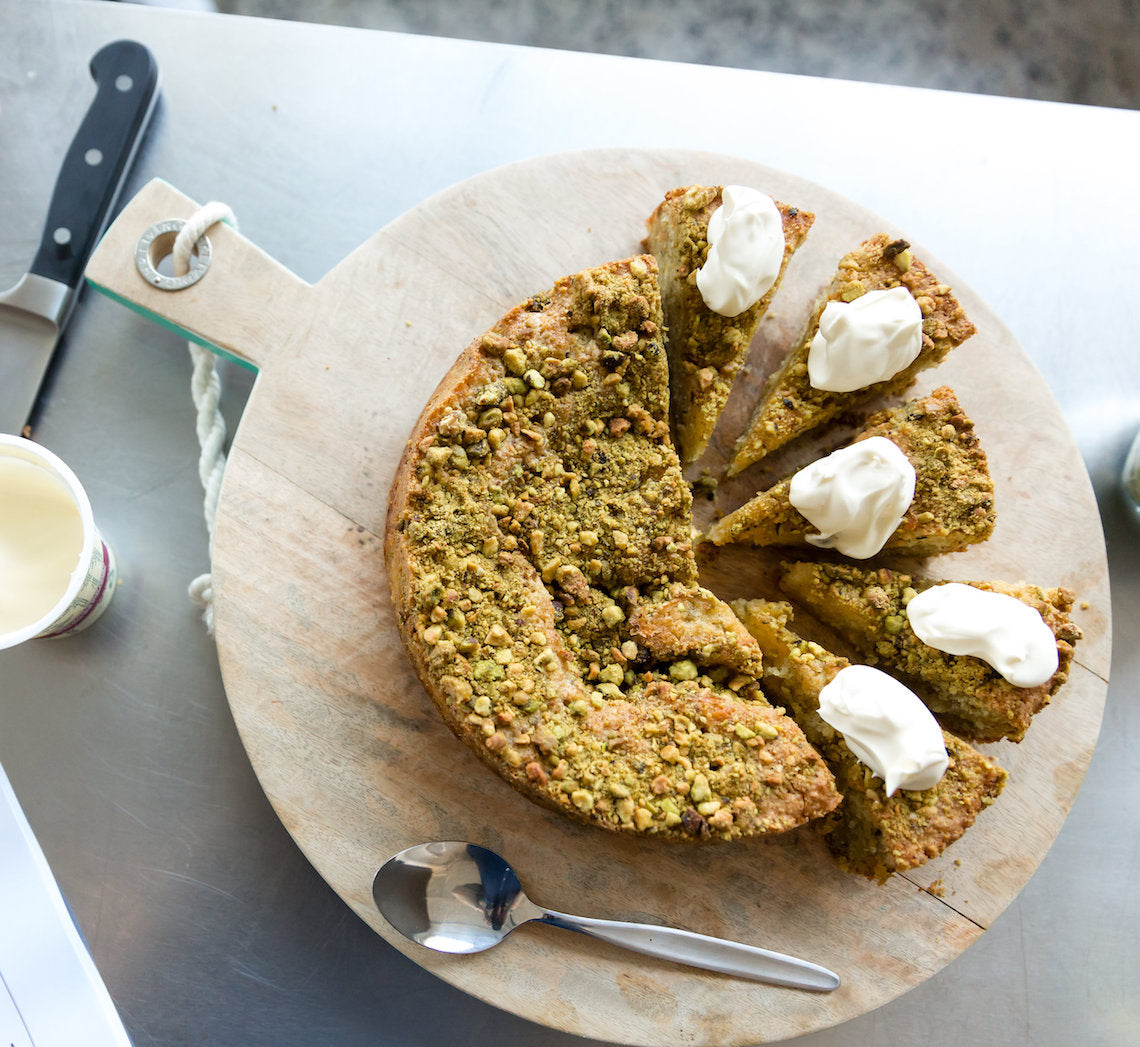
Prep 25min (+ lemon curd making time)Bake 50minMakes 10-12 serves
This wonderful cake was created by one of our Make Me a Baker graduates, Lisa Frost, for her graduation ceremony. Mor-ish with a lovely 'wholesomeness', the secret to this wonderful cake is that a layer of Lisa's vegan lemon curd is baked into the cake giving it a fabulously tangy, moist centre.
Ingredients
1 quantity Vegan Lemon Curd, chilled
Double / thick cream, to serve
2 tablespoons coarsely chopped pistachios, to serve
Cake
Cooking oil spray, to grease
160g (1¼ cups) finely chopped pistachios kernels
125g unsalted butter, at room temperature
150g (¾ cup) organic coconut sugar
1½ tablespoons finely grated lemon rind
50g (¼ cup) apple puree
3 eggs, at room temperature
100g (⅔ cup) plain cake flour
1 teaspoon baking powder
Method
- Preheat oven to 180°C (160°C fan-forced). Grease a 22cm round springform tin then line base and sides with 2 layers of baking paper. Spray the side lining paper with oil, avoiding the base of the pan. Place ¼ cup of the pistachios in the pan and rotate pan on its side to coat the side with nuts.
- Use an electric mixer to beat the butter, sugar and lemon rind until pale and creamy, scraping down the side of the bowl when necessary. Mix in the apple puree on low speed. Add the eggs one at a time, beating well after each addition until well combined.
- Sift together the flour and baking powder. Add ⅔ cup of the remaining pistachios and stir to combine. Use a large metal spoon or spatula to fold the dry ingredients into the egg mixture until just combined.
- Spoon the cake mixture into tin, spreading evenly. Drop the tin on the bench to settle the mixture. Spread 1 cup of the chilled curd over batter, spreading evenly. Sprinkle with the remaining pistachios. Cover the surface of the remaining curd with plastic wrap and return to the fridge.
- Bake for 40 minutes. Cover the surface of the cake lightly with a round of baking paper to prevent the nuts from burning and return to the oven for another 10 minutes or until a skewer inserted into the centre comes out clean (the top of the cake will still be slightly wobbly).
- Allow the cake to stand in the pan for at least 10 minutes before removing the side. Serve warm or at room temperature with the cream, remaining lemon curd and pistachios.
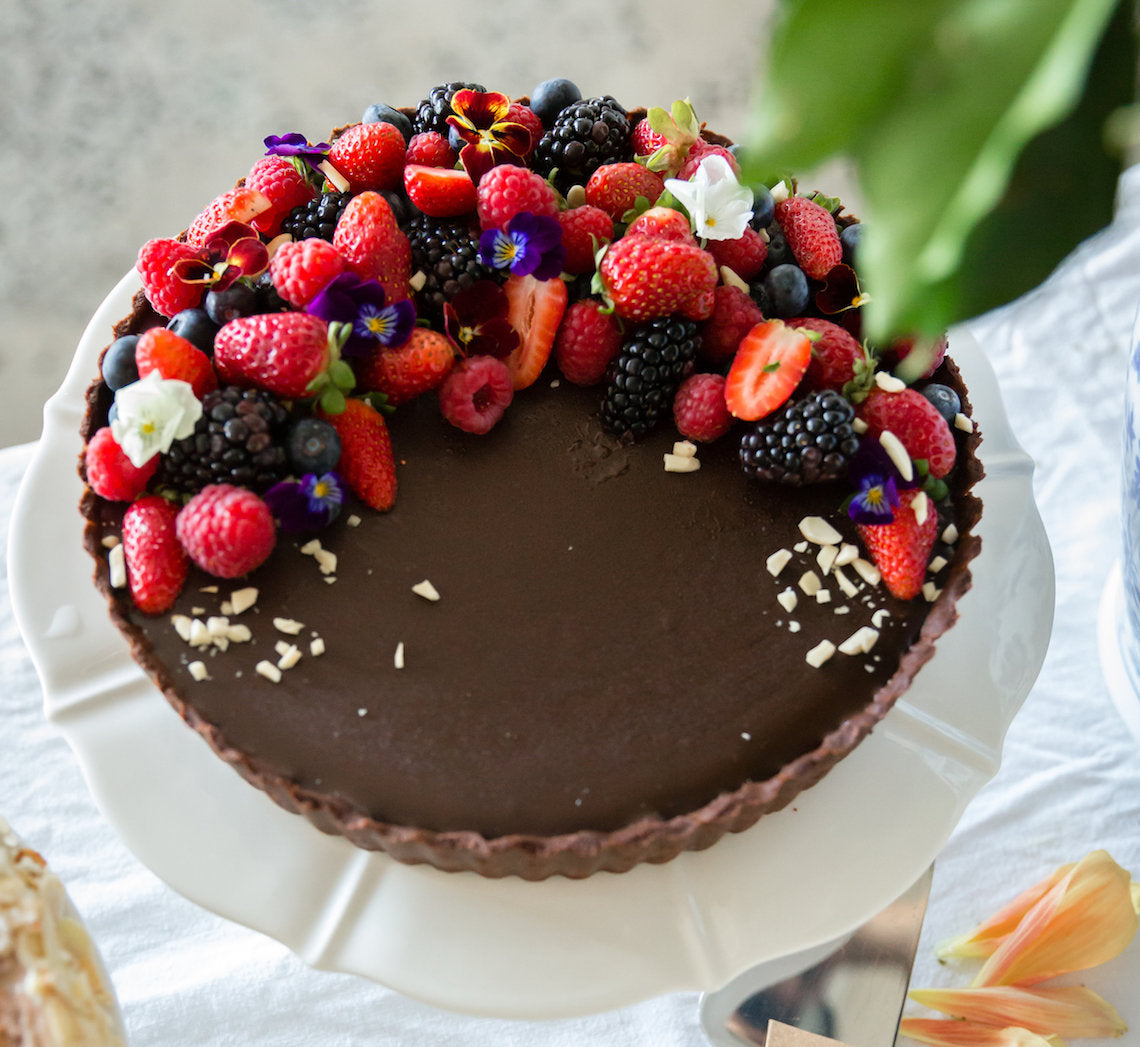
Prep 1hr 15min (+ cooling and chilling time)Bake 45-75minMakes 8-10 serves
One of our Make Me a Baker graduates, Dimi Jayawardene, baked this beautiful tart at her graduation ceremony – chocolate pastry filled with a chocolate custard and topped with chocolate ganache, it's the definition of decadent!
Ingredients
To Serve
Raspberries, blueberries and strawberries
Slivered almonds
Gold leaf
Edible flowers
Whipped cream
Chocolate Shortcrust Pastry
200g (1⅓ cups) plain flour
Good pinch salt
3 tablespoons icing sugar, sifted
2 tablespoons cocoa powder, sifted
150g chilled unsalted butter, cubed
3-3½ tablespoons iced water
Chocolate Custard Filling
4 egg yolks
1 tablespoon custard powder
2 tablespoons caster sugar
200g good-quality dark chocolate, chopped
300ml thin cream
250ml (1 cup) milk
Chocolate Ganache
125ml (1/2 cup) thickened cream
250g good-quality dark chocolate, chopped
20g butter
2-3 tablespoons Tia Maria, or to taste
Method
- To make the pastry, combine the flour, salt, icing sugar and cocoa powder in a large mixing bowl. Add the chilled butter. With your palms facing upwards, use your fingertips to rub in the butter until the mixture resembles fine breadcrumbs with some larger pieces of butter still visible.
- Sprinkle 3 tablespoons of the iced water over the flour and butter mixture. Use a round-bladed knife in a cutting motion to mix until evenly combined and the mixture starts holding together. Press a little of the mixture between your fingers – if it holds together easily, there is no need to add more water; If it doesn’t add the remaining ½ tablespoon water and combine. The pastry should be soft but not sticky.
- Bring the pastry together with your hands and transfer to a lightly floured, cool bench top. Lightly knead the pastry with your fingertips for about 10 seconds or until it comes together but isn’t completely smooth. Shape the pastry into a disc, wrap well in plastic wrap and place in the fridge for 20 minutes to rest.
- Preheat oven to 200°C (180°C fan-forced). Roll pastry on a lightly floured surface to a 4mm-thick disc. Line the base and side of a 23cm (base measurement) round, fluted tart tin with removable base, pressing into the sides. Roll the rolling pin over the top to trim any excess pastry. Place in the fridge for 15 minutes to rest.
- Place the tart tin on an oven tray. Line the pastry with baking paper and fill with baking beads, or dried rice or beans. Bake in preheated oven for 10-15 minutes. Remove the rice or beans and bake for a further 5-10 minutes or until pastry is just cooked through. Reduce oven temperature to 180°C (160°C fan-forced).
- Meanwhile, to make the Chocolate custard filling, combine the egg yolks, custard powder and sugar in a saucepan. Add the chocolate, cream and milk and place over low heat. Cook, stirring occasionally with a balloon whisk, for 5 minutes or until chocolate melts and mixture is smooth. Remove from heat.
- Pour the chocolate custard mixture into the pastry case (see Baker's Tips). Reduce oven temperature to 180°C (160°C fan-forced) and bake for 20-40 minutes or until custard is just set. (The baking time will depend on your oven and a the depth of your tart tin.) Remove from oven and set aside to cool completely in the tin.
- While the tart is cooling, make the Chocolate ganache. Heat the cream for 30-50 seconds or until bubbling in the microwave. Place the chocolate, butter and Tia Maria in a bowl. Pour the cream into the bowl. Let it sit for 1-2 minutes until chocolate is melted and then start mixing with a small balloon whisk or spoon until the mixture is beautiful and smooth (the butter gives the ganache a lovely glossy look). Pour the ganache over the layer of custard and place in the fridge to set.
- Transfer the tart to a serving plate. Top with berries and slivered almonds, decorate with gold leaf and edible flowers. Serve with whipped cream.
Baker's Tips
- Adding the filling to the pastry cases while still sitting in the oven on the tray will mean you can fill the tart completely and minimise the chance of it spilling when transferring it to the oven.
- This recipe makes one large tart or it can make 8 individual tarts in 10-11cm tins.
- The tart can be made the day before. Leave the decorating for the day of serving.
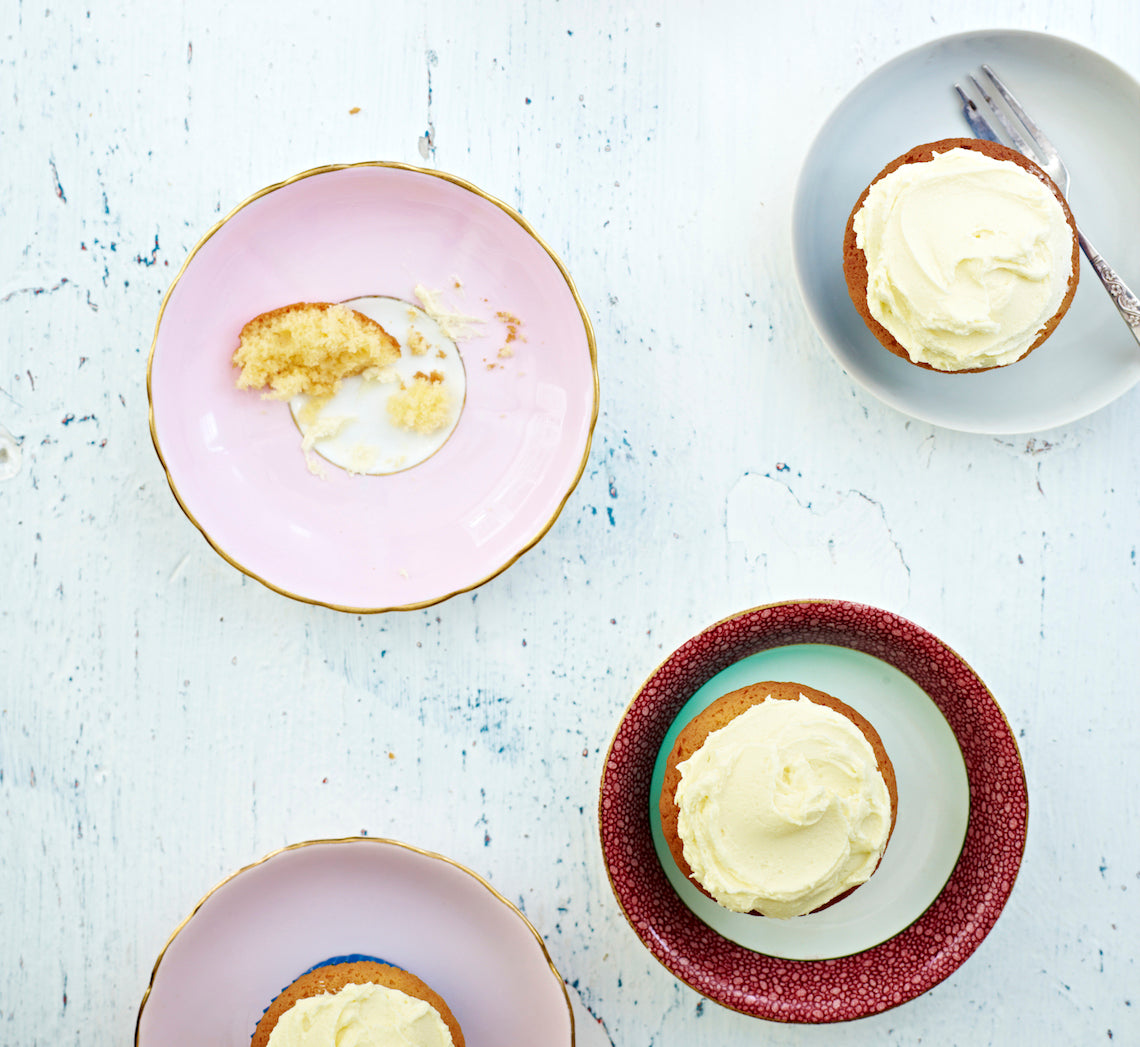
Prep 15min (+35min cooling time)Bake 20-25minMakes 12
A good basic vanilla cupcake recipe is a must in anyone's repertoire. This one is not only super simple but also incredibly reliable – just make sure your butter is at room temperature and soft enough to make an indent when you press your finger into it lightly. The Vanilla Buttercream quantity will make enough for piping it onto your cupcakes, but if you prefer to spread it you only need to make half the quantity.
Ingredients
185g (1¼ cups) self-raising flour
165g (⅔ cup) caster sugar
125g butter, softened
80ml (⅓ cup) milk
2 eggs, at room temperature
2 teaspoons Queen Natural Vanilla Extract or Essence
Edible sprinkles of your choice (optional)
Vanilla Buttercream
250g salted butter, at room temperature
2 teaspoons Queen Natural Vanilla Extract or Essence
60ml (¼ cup) thickened cream, plus extra if required
350g icing sugar mixture, sifted
Method
- Preheat the oven to 180°C (160°C fan-forced). Line a 12-hole 80ml (⅓ cup) muffin tin with paper cases.
- Place the flour, sugar, butter, milk, eggs and vanilla in a large mixing bowl. Use an electric mixer to beat on low speed until combined. Increase the speed to high and beat for 3 minutes or until the mixture is well combined, creamy and very pale in colour. Spoon the mixture into the paper cases, dividing evenly.
- Bake for 20-25 minutes or until the cupcakes are golden and a skewer inserted into the centre comes out clean. Cool for 5 minutes in the tin, then transfer to a rack to cool completely (this will take about 30 minutes).
- To make the Vanilla buttercream, use an electric mixer to beat the butter and vanilla , scraping down the side of the bowl when necessary, until very pale and creamy. Add the cream and beat on medium speed for 1-2 minutes or until very creamy. Add the icing sugar and beat on low speed until combined. Increase speed to medium-high and beat for 2-3 minutes or until light, creamy and a good spreading or piping consistency. Beat in another tablespoon of cream if the buttercream needs thinning slightly.
- Pipe or spread the buttercream onto the cooled cupcakes and decorate, if desired.
Baker's Tip
- These cupcakes will keep in an airtight container at room temperature in a cool spot for up to 2 days.
Photography by Julie Renouf.
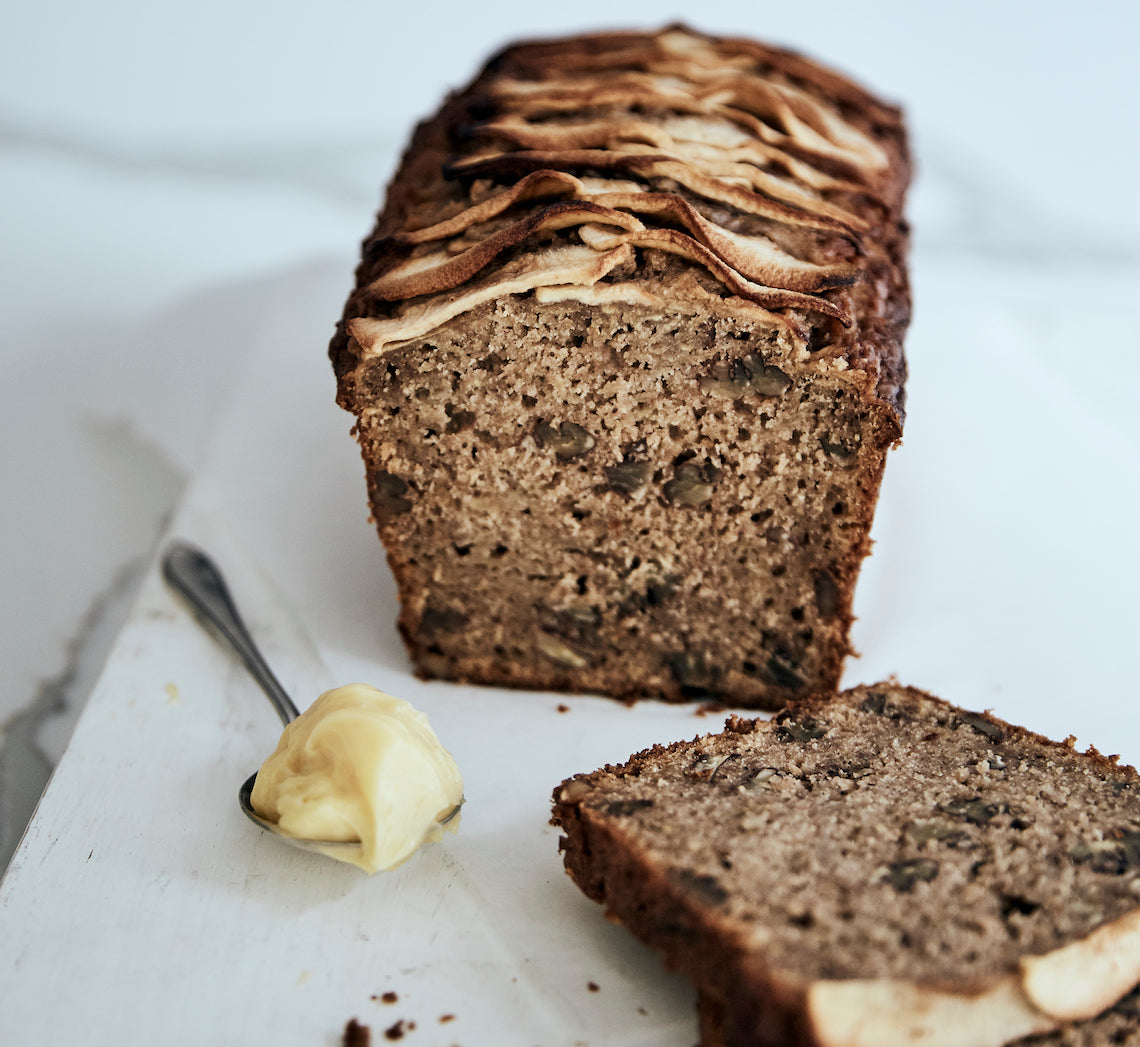
Prep 30minBake 1hr 30minMakes 12 slices
Flavoursome, fruity and deeply satisfying this apple loaf is the essence of Autumn. Perfectly teamed with the whipped honey butter, but fresh ricotta and honey also makes a wonderful topping.
Ingredients
Apple Bread
150g (5½oz/1 cup) plain flour
150g (5½oz/1 cup) plain wholemeal flour
2½ teaspoons baking powder
1 teaspoon ground cinnamon
1 teaspoon mixed spice
220g (7¾oz/1 cup, firmly packed) brown sugar
100g (3½oz/1 cup) pecans, toasted and coarsely chopped
4 medium (about 160g/5⅔oz each) Granny Smith, golden delicious, gala or pink lady apples
2 eggs, at room temperature, lightly whisked
125ml (4fl oz/½ cup) sunflower or light olive oil, plus extra to grease
2 teaspoons natural vanilla essence or extract
Whipped Honey Butter
125g (4½oz) salted butter, at room temperature
2 tablespoons floral honey
1 teaspoon natural vanilla essence or extract
Method
- Preheat oven to 180°C/350°F (160°C/315°F fan-forced). Brush a 8.5cm x 17.5cm (3⅓in x 6¾in), base measurement, loaf tin with a little extra oil to grease and line the base and two long sides with one piece of baking paper.
- Sift together the flours, baking powder, cinnamon and mixed spice into a large bowl, returning any husks from the flour to the bowl. Stir in the sugar and pecans.
- Core and then coarsely grate 3 of the apples. Place in a medium bowl. Add the eggs, oil and vanilla and use a fork to whisk together until evenly combined. The apple mixture to the dry ingredients and use a large metal spoon or spatula to fold together until just combined.
- Spoon the mixture into the prepared tin and smooth the surface with the back of a spoon. Peel, quarter, core and thinly slice the remaining apple and arrange on the top of the loaf. Bake in preheated oven for 1 hour 30 minutes or until a skewer inserted into the centre comes out clean. Stand in the tin for 5 minutes before turning onto a wire rack to cool.
- Meanwhile, to make the Whipped Honey Butter, use an electric mixer to beat the butter, honey and vanilla essence or extract until pale and creamy. Transfer to a serving dish, cover and set aside in a cool place.
- Cut the apple bread into 2cm-thick slices. Serve fresh or toasted, spread with the Whipped Honey Butter.
Baker's Tips
- This apple bread will keep in an airtight container at room temperature for up to 3 days.
- This bread is delicious served toasted. If you wish to toast it, make it without the sliced apple on top as it tends to burn during toasting.
- To freeze, cut into slices and either wrap each slice separately in plastic wrap or separate the slices with freezer wrap. Seal in a plastic bag and freeze for up to 3 months. Thaw at room temperature or toast straight from the freezer.
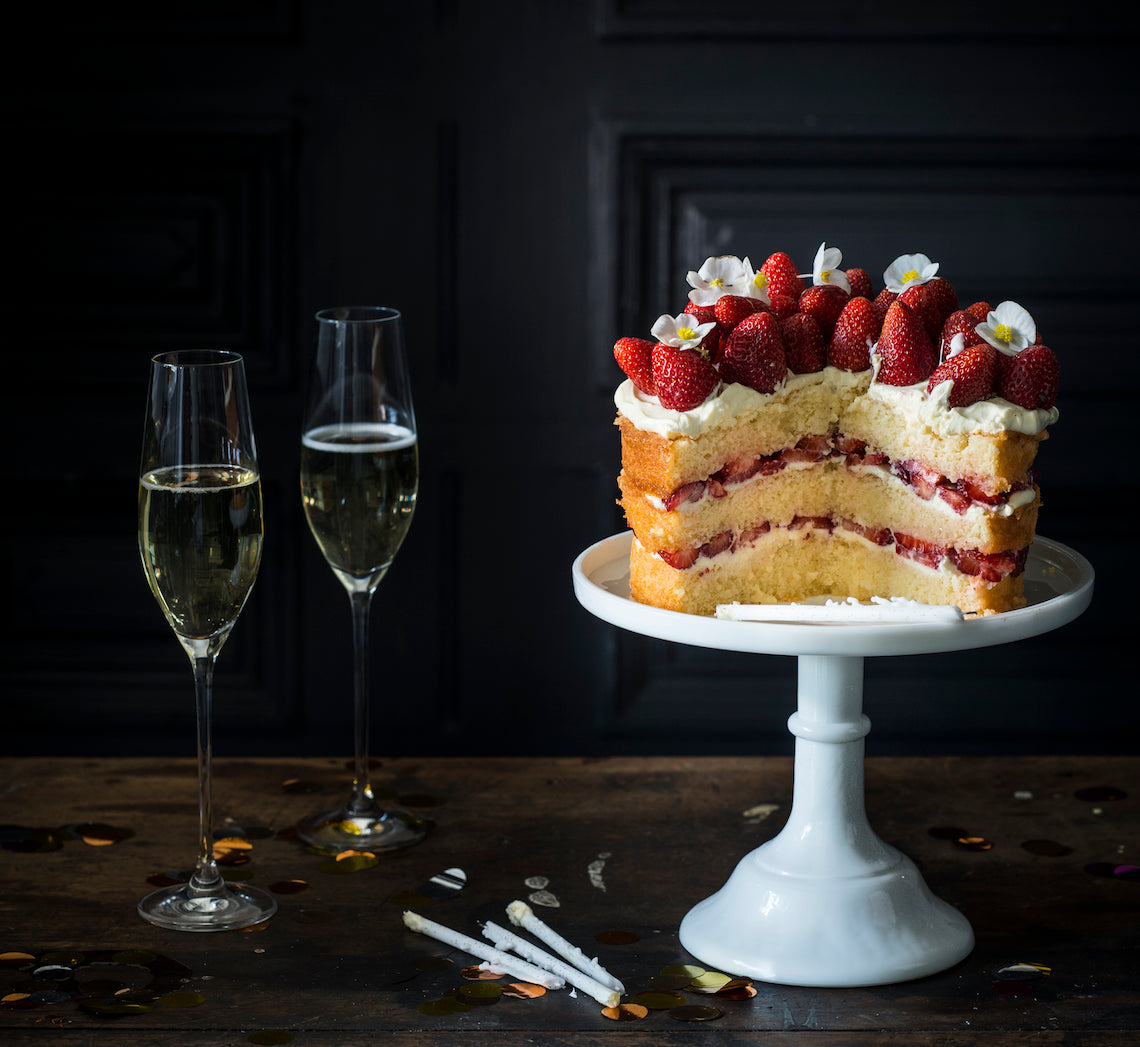
Prep 40min (+ 30min cooling time)Bake 30minMakes 8-10 serves
If there ever was a cake that epitomised the flavours of England this would be it! The combination of elderflower, strawberries and gin not only make this chic sponge cake uniquely special but also incredibly lust-worthy.
Ingredients
250g ripe strawberries, hulled and sliced
500g small ripe strawberries, to serve
icing sugar, to dust
fresh elderflowers (optional), to decorate (see Baker’s Tips)
Mascapone cream
185ml pure (thin/pouring) cream
250g mascarpone
2 tablespoons undiluted elderflower cordial /drink concentrate, or to taste
Sponge layers
Melted butter, to grease
4 fresh eggs, at room temperature
1½ teaspoons natural vanilla essence or extract
165g (¾ cup) caster sugar
60ml (¼ cup) milk
30g butter, diced
110g (¾ cup) self-raising flour
30g (¼ cup) cornflour
Elderflower and gin syrup
165ml (¾ cup) undiluted elderflower cordial /drink concentrate
60ml (¼ cup) strained fresh lemon juice
80ml (⅓ cup) gin
Method
- To make the sponge layers, place the oven rack in the oven so that the cake tins will sit in the middle of the oven and then preheat it to 180°C (160°C fan-forced). Brush three 18cm non-stick springform tins with a melted butter to grease.
- Use an electric mixer with a whisk attachment on medium-high speed to whisk the eggs and vanilla in a large bowl until frothy. Add the sugar a spoonful at a time, whisking well between each addition, until the mixture is very thick and pale and the sugar has dissolved (this will take about 8 minutes). Lift the whisk out of the mixture and slowly draw a figure eight, if the trail stays on the surface long enough for you to finish drawing then the mixture is ready. If not, continue to whisk for a further minute and then test again.
- Meanwhile, heat the milk and butter in a small saucepan over medium heat until the butter melts and mixture is almost simmering. Remove from the heat. Pour the hot milk mixture down the side of the bowl then quickly sift the flour and cornflour together over the whole surface of the egg mixture. Immediately whisk briefly again with the electric mixer on low speed, until the flour mixture is just incorporated (make sure there is no flour caught at the bottom of the bowl and be careful not to overmix).
- Divide the mixture evenly between the cake tins and gently tap the tins on the bench top three times to settle the mixture. Bake in preheated oven for 15 minutes or until the cakes are a pale golden colour, spring back when lightly touched in the centre and start pulling away from the sides of the tins. Remove from the oven and stand for 1 minute before turning onto a wire rack over a tray, top side up.
- Meanwhile, to make the Elderflower and gin syrup combine the elderflower cordial /drink concentrate and lemon in a small saucepan and heat over medium heat until hot but not simmering. Remove from heat and stir through the gin.
- Use a skewer to prick the warm sponge layers all over. Gradually pour the hot syrup over the warm cake, allowing it to soak in. Set aside to cool completely (this will take about 30 minutes).
- When ready to assemble, use a hand-held electric mixer with a whisk attachment or a balloon whisk to whisk the cream in a medium mixing bowl on medium-low speed until soft peaks form. Add the mascarpone and elderflower cordial /drink concentrate and whisk on low speed briefly until just combined and thickened to a medium whipped cream consistency. Place one layer of the sponge on a serving plate or cake stand and dollop a third of the mascarpone cream evenly over the top. Use the back of a metal spoon to gently spread the cream from the centre of the cake towards the outside to cover, leaving about a 1cm border around the edge. Then top with half the sliced strawberries. Top with another sponge layer, half of the remaining cream and remaining sliced strawberries. Top with the remaining sponge layer and spread with the remaining cream. Decorate with the whole strawberries.
Baker's Tips
- I used white Waxed Leaf Bergonias to decorate this cake.
- This cake can be assembled about 2 hours before serving. Stand at room temperature in a cool spot.
- The sponge cake layers will keep in airtight container, divided by baking paper, at room temperature for up to 2 days.
How to cut a multi-layer sponge cake
Cakes with multiple layers, especially those made up of various textures such as sponge cakes, can be tricky to cut the traditional way – cutting downwards often squashes the cake, causing the softer filling to ooze unevenly out the side and leaving you with an unsightly mess.
The trick to avoid this, is to use a sharp serrated knife that has a pointed end and is at least the length of the height of the cake.
Insert it into the centre of the cake vertically and use a gentle, slow sawing action to cut the cake. The layers will miraculously stay intact as each slice is cut and removed from the cake.
This recipe is from Anneka's SBS Food online column Bakeproof: Celebration Cakes. Click here for more Bakeproof columns and recipes.
Photography by Alan Benson.
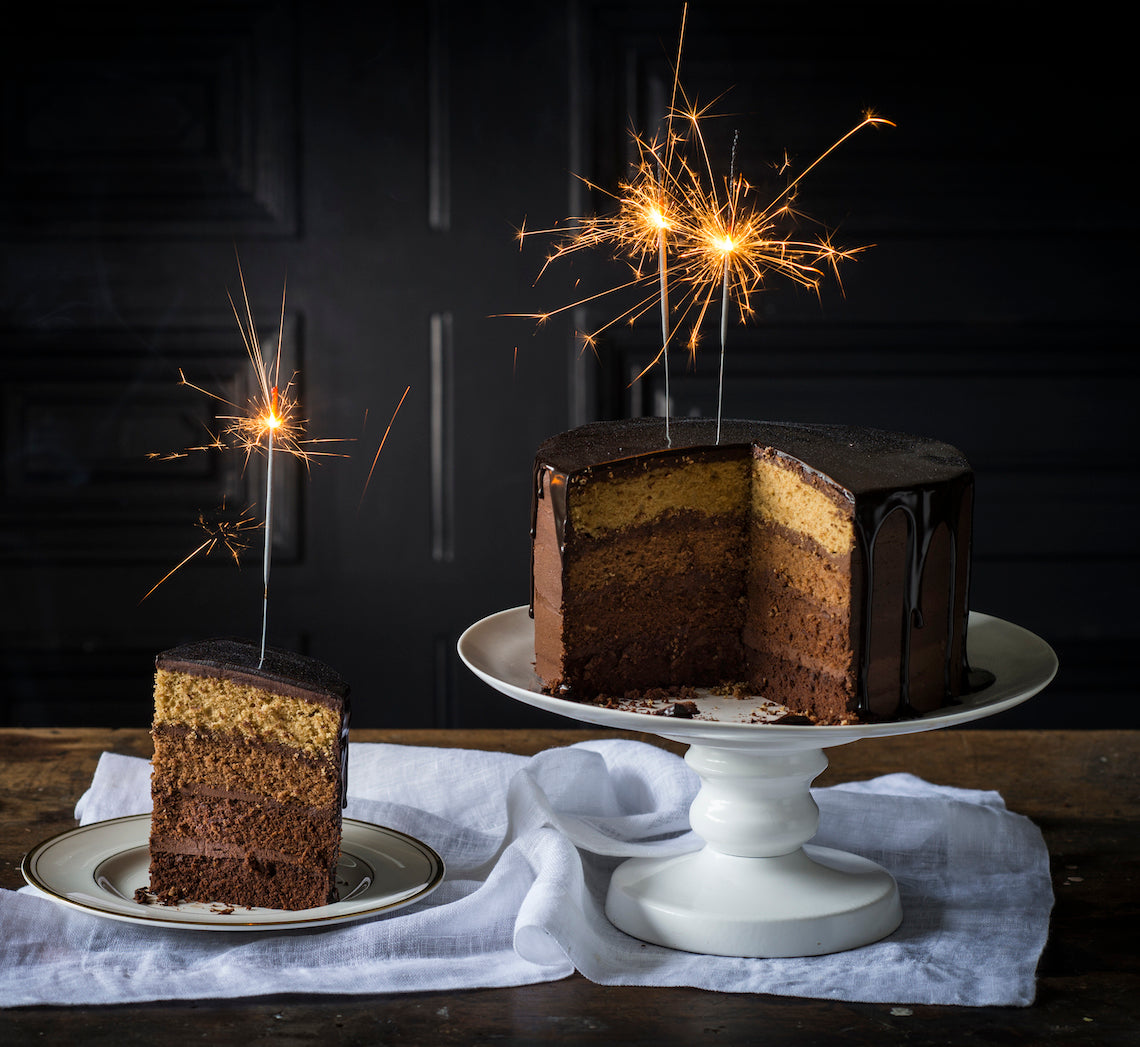
Prep 1hr (+45min cooling and 1-1hr30min chilling time)Bake 20minMakes 12-14 serves
If you're a chocoholic this cake is heaven. And if you're not, it's still heaven! Wickedly rich and strikingly handsome, this layered centrepiece demands attention no matter what the celebration.
Ingredients
Cake layers
melted butter, to grease
250g butter, cubed, softened
330g (1½ cups) caster sugar
3 teaspoons natural vanilla essence or extract
4 eggs
225g (1½ cups) plain flour
225g (1½ cups) self-raising flour
250ml (1 cup) milk
1 tablespoon instant coffee granules dissolved in 1 tablespoon boiling water, cooled
Dark chocolate layer
30g (¼ cup) Dutch cocoa powder, sifted and combined with 60ml (¼ cup) hot tap water, cooled
Milk chocolate layer
1½ tablespoons Dutch cocoa powder, sifted and combined with 1½ tablespoons hot tap water, cooled
Light chocolate layer
2 teaspoons Dutch cocoa powder, sifted and combined with 2 teaspoons hot tap water, cooled
Whipped chocolate ganache
500g good-quality dark chocolate (45-54% cocoa), chopped
300ml pure (pouring / thin) cream
Chocolate drip icing
100g good-quality dark chocolate (45-54% cocoa), chopped
100ml pure (think / pouring) cream
2 tablespoons corn syrup
Method
- To make the Cake layers, preheat the oven to 190°C (170°C fan-forced). Grease four shallow 20cm round cake tins with melted butter and line the bases with non-stick baking paper.
- Prepare the Dark, Milk and Light chocolate layer mixtures and set aside.
- Use an electric mixer to beat the butter, sugar and vanilla in a large mixing bowl until pale and creamy. Add the eggs one at a time, beating well after each addition (the mixture will look curdled at this stage).
- Sift together both the flours. Combine the milk and coffee mixture. Add half the flour mixture to the butter mixture and beat on lowest possible speed until just combined. Add the milk and coffee mixture and beat on lowest possible speed until just combined and then beat in the remaining flour mixture until just combined.
- Divide the cake batter between four bowls (each will have about 360 g of mixture). Add the Dark chocolate layer mixture to one portion and stir gently to combine. Add the Milk chocolate layer mixture to one portion and stir gently to combine. Add the Light chocolate layer mixture to one portion and stir gently to combine. Leave the fourth portion as it is
- Spoon each of the batters into a prepared tin and smooth the surface with the back of a spoon. Bake in preheated oven for 15 minutes. Swap the cake tins around and bake for a further 5 minutes or until a skewer inserted into the centres comes out clean.
- Stand the cakes in the tins for 5 minutes before turning onto a wire rack to cool (this will take about 30 minutes).
- To make the Whipped chocolate ganache, put the chocolate and cream in a heatproof bowl over a saucepan of simmering water (make sure the bottom of the bowl doesn’t touch the water). Stir often with a metal spoon just until the chocolate melts and the mixture is smooth. Immediately remove the bowl from the saucepan, cover with plastic wrap and place the fridge for 1-1½ hours, stirring briefly about every 5 minutes, or until cooled and thickened to a spreadable consistency. Use an electric mixer fitted with a whisk attachment to whisk the chocolate mixture in a medium bowl on low speed for 1-2 minutes or until light and fluffy (be careful not to over whisk).
- To assemble the cake, set aside about a quarter of the Whipped chocolate ganache in a bowl for piping. Place the Dark chocolate cake layer, top side down on a cake stand or serving plate. Spread evenly with about ⅓ cup of the remaining Whipped chocolate ganache. Repeat with the remaining cake layers (from darkest to lightest) with about ⅓ cup of the ganache between each. Spread the remaining buttercream over the top and sides of the cake, using a large palette knife to smooth. Place the cake in the fridge for at least 30 minutes to chill.
- To make the Chocolate drip glaze, place the chocolate in a heatproof bowl and set aside. Combine the cream and corn syrup in a small saucepan and heat over a medium heat, stirring frequently, until almost simmering. Pour over the chocolate and set aside for 1 minutes. Stir until smooth and well combined. Place in the fridge for 15 minutes, stirring occasionally, until almost cooled to room temperature.
- Spoon the Chocolate drip glaze onto the center of the chilled cake and use the back of a metal tablespoon to spread to cover. Gently push some of the glaze over the edge all the way around to form a drip pattern. Set aside in a cool spot for about 15 minutes or until the glaze is set before cutting.
Baker's Tips
- This cake will keep in an airtight container at room temperature in a cool spot for up to 3 days.
How to decorate a cake with a drip glaze
There are a few things to keep in mind when creating a luscious glossy drip glaze on a cake.
Make sure the iced cake has been chilled for at least 30 minutes before decorating with the glaze as this will help the drips down the side of the cake set before reaching the base of the cake.
Gradually spoon the slightly warm (it should be slightly warmer than room temperature) glaze onto the centre of the cake, allowing it to flow naturally towards the edge.
Then use the back of a metal tablespoon to carefully ‘push’ the glaze towards the outside, smoothing the top and allowing small amounts of the glaze to flow over the edge and down the side of the cake to form a drip pattern.
The key is to take it slowly, not add too much glaze at one time and don’t push too firmly with the spoon as the drips will become large and cover more of the side of the cake than you want.
This recipe is from Anneka's SBS Food online column Bakeproof: Celebration Cakes. Click here for more Bakeproof columns and recipes.
Photography by Alan Benson.
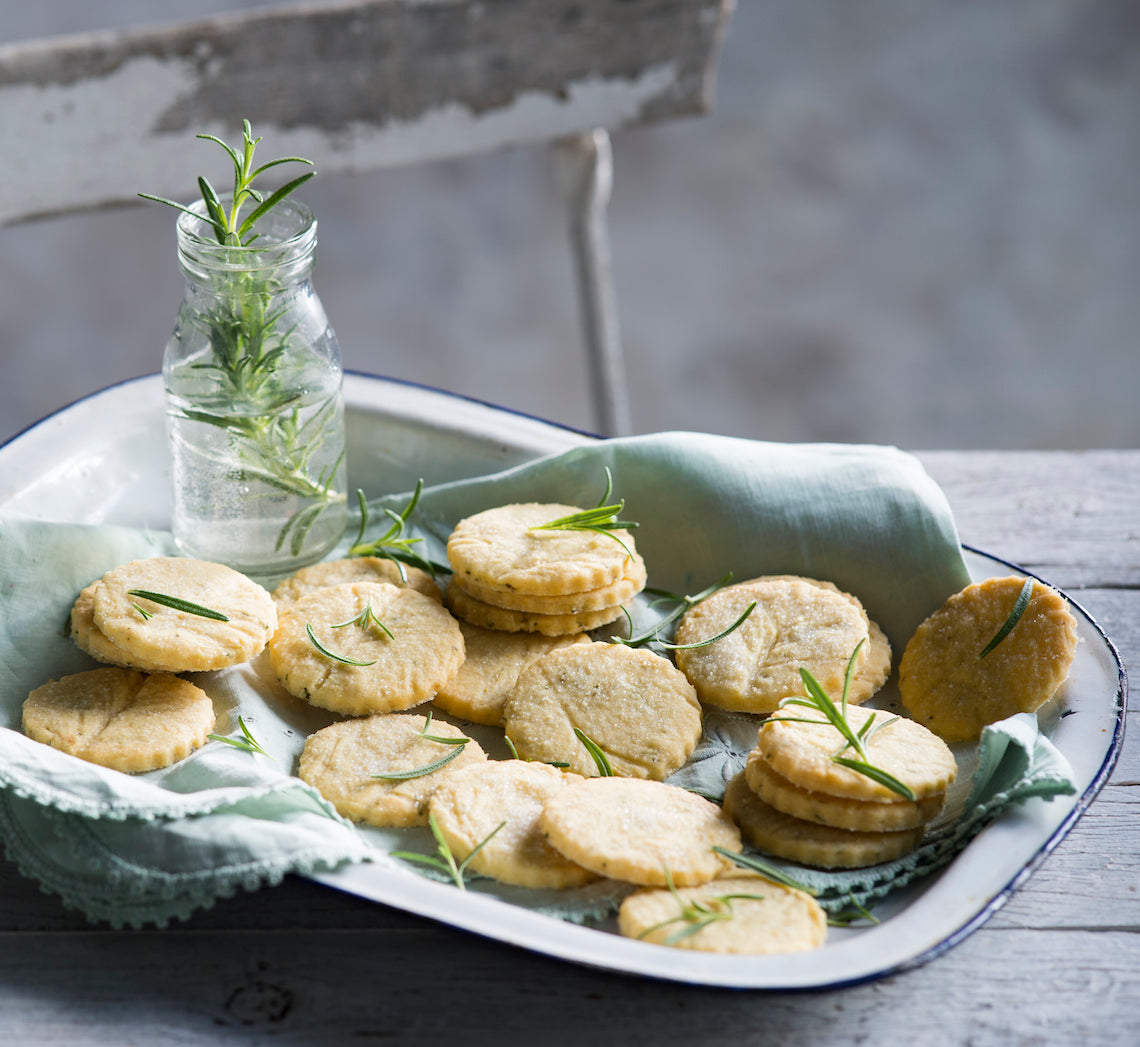
Prep 30min (+ 1hr chilling time)Bake 15-20min (per batch)Makes about 80
Along with lemon, these melt-in-the-mouth biscuits are scented with rosemary’s distinct, yet subtle, earthy and slightly sweet flavour. The clever imprinting of rosemary sprigs of the dough gives a gorgeous finish to these sweet, buttery mouthfuls.
Ingredients
250g (9oz) salted butter, cubed and softened slightly
165g (¾ cup/5¾oz) granulated white sugar, plus 2 tablespoons extra to sprinkle
1 egg yolk
335g (2¼ cups/8¼oz) plain flour
1½ tablespoons finely chopped fresh rosemary (see Baker’s Tips)
1 lemon, rind finely grated
Small rosemary sprigs, to imprint biscuits
Method
- Line 3 large oven trays with baking paper.
- Use an electric mixer with a paddle attachment to beat the butter and sugar for about 1 minute or until starting to become pale and creamy but not too aerated (do not over beat). Beat in the egg yolk, rosemary and lemon until just combined.
- Add the flour to the butter mixture and beat on low speed until just combined and a soft dough forms.
- Divide the dough in half and shape each portion into a disc about 2cm/¾in thick. Wrap separately in plastic wrap and place in the fridge for 30 minutes to chill.
- Use a lightly floured rolling pin to roll a portion of dough out on a lightly floured bench top until 4mm/⅛in thick. Arrange the rosemary sprigs over the dough and lightly roll over with the rolling pin to imprint. Remove the rosemary sprigs and reserve. Use a 4.5cm/1¾in fluted round biscuit cutter to cut the dough into rounds and place on the lined trays, re-rolling, imprinting and cutting out any off cuts. Repeat with the remaining portion of dough. Sprinkle the biscuits liberally with the extra sugar.
- Place the trays in the fridge for 30 minutes to chill.
- Preheat oven to 170°C/340°F (150°C/300°F fan-forced)
- Bake 2 trays of the biscuits in preheated oven for 15-20 minutes, swapping the trays around half way through baking, or until pale golden and cooked through. Cool on the trays. Repeat with the remaining tray of biscuits, baking in the centre of the oven.
Baker's Tips
- Chopping the rosemary with a pinch of sugar will help bring out its aromatic flavours.
- These biscuits will store in an airtight container at room temperature for up to week.
This recipe is from Anneka's SBS Food online column Bakeproof: Christmas Baking with Fresh Herbs. Click here for more Bakeproof columns and recipes.
Photography by Alan Benson.
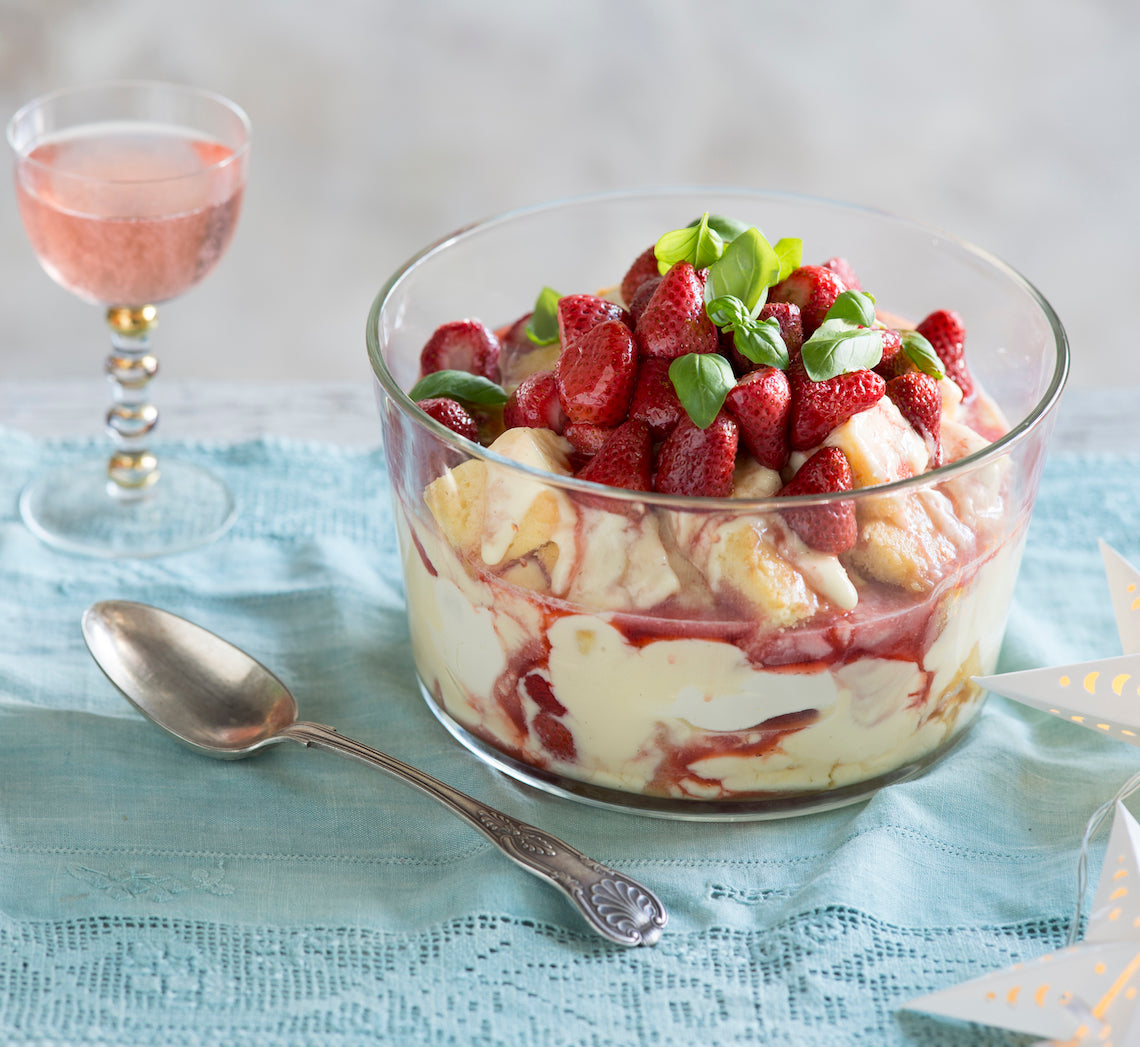
Prep 1hr (+ 2hr cooling time)Bake 30minMakes 10-12 serves
Fragrant, sweet and fresh, basil brings something truly special to this festive trifle. Layers of vanilla buttercake soaked with a basil and lemon syrup, creamy basil-infused custard and roasted strawberries make for a wonderful combination in this impressive dessert… I promise one serve won’t be enough!
Ingredients
125 ml (½ cup) pure (pouring / thin) cream
Small fresh basil leaves, to decorate
Buttercake
110g (¾ cup) self-raising flour
75g (½ cup) plain flour
165g (¾ cup) caster sugar
125g butter, softened
80ml (⅓ cup) milk
2 eggs, at room temperature
1 teaspoon natural vanilla extract or essence
Basil-infused custard
500ml (2 cups) milk
125ml (½ cup) pure (pouring / thin) cream
20 medium fresh basil leaves
75g (⅓ cup) caster sugar
2 tablespoons cornflour, sifted
3 egg yolks, lightly whisked
1 teaspoon natural vanilla essence or extract
Roasted strawberries
1kg strawberries, hulled and halved if large
75g (⅓ cup) caster sugar
Basil and lemon syrup
165g (¾ cup) caster sugar
125ml (½ cup) water
10 medium fresh basil leaves
60ml (¼ cup) strained fresh lemon juice
Method
- To make the Basil-infused custard, put the milk, cream and basil leaves into a medium saucepan. Bring just to a simmer over a medium heat. Remove from heat and stand for 30 minutes to infuse. Remove the basil leaves. Use a balloon whisk to whisk the sugar and cornflour together in a heatproof bowl. Gradually whisk in the milk mixture until smooth and well combined. Whisk in the egg yolks. Return to the heat and stir constantly with the whisk over medium heat until the mixture thickens and just comes to a simmer. Remove from the heat and stir in the vanilla. Pass the custard through a sieve into a heatproof bowl. Cover the surface with plastic wrap and refrigerate for 2 hours or until chilled.
- To make the Buttercake, preheat the oven to 180°C (160°C fan-forced). Grease a 20 x 30 cm (base measurement) shallow cake tin and line the base and two longs sides with one piece of baking paper.
- Place both the flours, sugar, butter, milk, eggs and vanilla in a large mixing bowl. Use an electric mixer to beat on low speed until combined. Increase the speed to medium and beat for 3 minutes or until the mixture is smooth, creamy and very pale in colour. Spoon the mixture into the lined tin and spread evenly using the back of a spoon. Bake in preheated oven for 18-20 minutes or until cooked when tested with a skewer. Cool for 5 minutes in the tin, then turn onto a wire rack to cool.
- To make the Roasted strawberries, preheat oven to 200°C (180°C fan-forced). Toss the strawberries with the sugar in a bowl. Spread over an oven tray in a single layer. Roast in preheated oven for 10 minutes, stirring gently after 5 minutes, or until the strawberries are soft but still holding their shape. Set aside to cool.
- To make the Basil and lemon syrup, combine the sugar and water in a small saucepan and site over medium heat until the sugar dissolves. Add the basil, bring to a simmer and simmer for 5 minutes or until reduced slightly. Stir in the lemon juice. Set aside to cool.
- To assemble the trifle, use a balloon whisk or a hand held electric whisk on medium speed to whisk the cream in a medium bowl until soft peaks form. Cut the buttercake into 3cm cubes and place half of the cake over the base of a 2-3 liter (8-12 cup) serving dish. Drizzle the cake with half the Basil and lemon syrup. Spread half the Basil-infused custard over the top. Spoon half the Roasted strawberries over the custard and then top with all of the whipped cream. Repeat the layering with the remaining ingredients finishing with the roasted strawberries. Decorate with the basil leaves and serve in large scoops.
Baker's Tips
- The butter cake can be made up to 3 days ahead of using. Keep in an airtight container at room temperature.
- The Basil-infused custard, Roasted strawberries and Basil and lemon syrup can all be made up to 3 days ahead of serving. Keep separately in airtight containers in the fridge.
- This trifle can be assembled up to 8 hours ahead of serving. Top with fresh strawberries, dust with icing sugar and decorate with basil just before serving.
This recipe is from Anneka's SBS Food online column Bakeproof: Christmas Baking with Herbs. Click here for more Bakeproof columns and recipes.
Photography by Alan Benson.
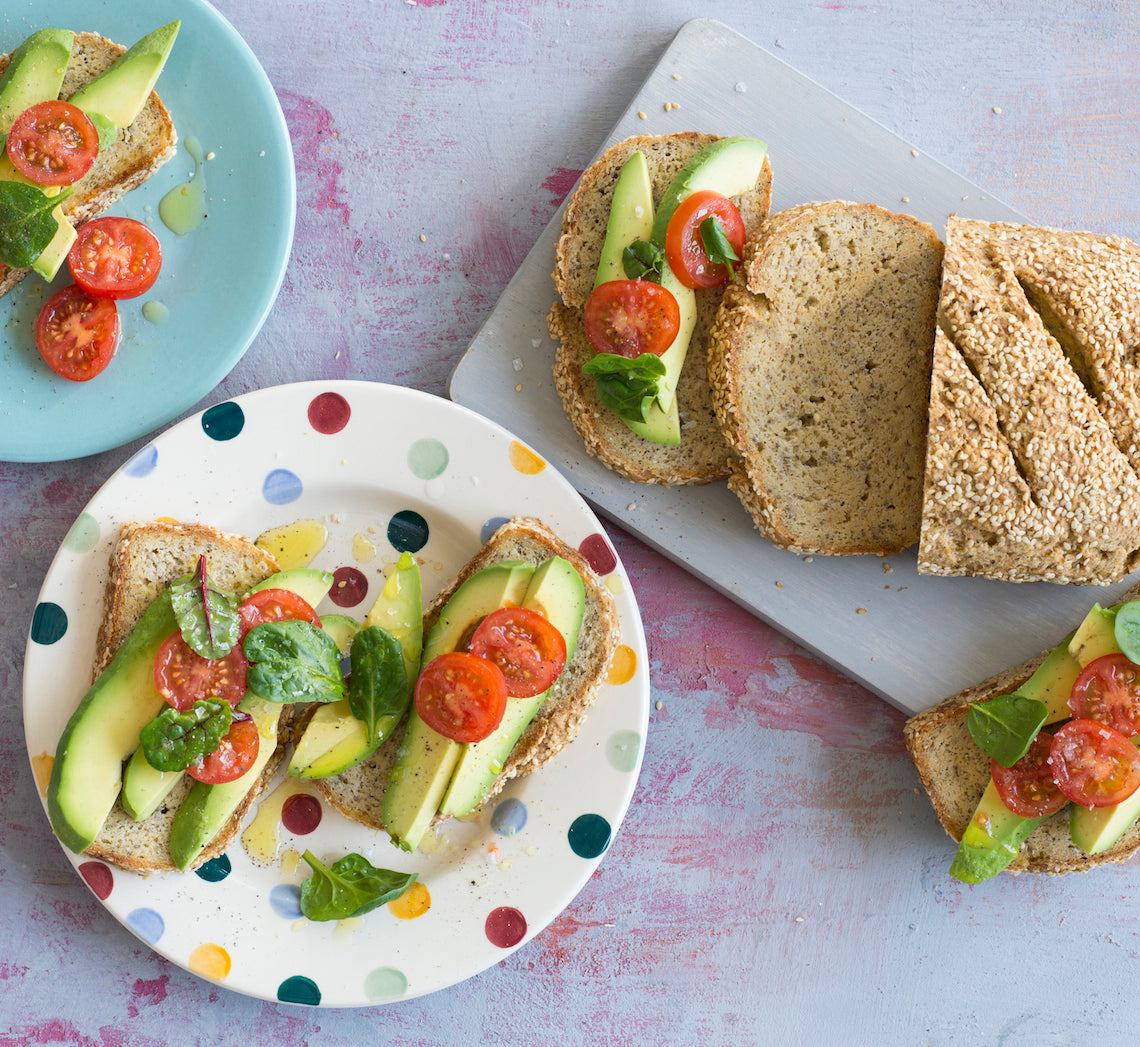
Prep 30min (+1hr30min cooling time)Bake 1hr 10minMakes 1 loaf
This bread is almost the complete opposite of most commercially made gluten-free breads - wonderfully substantial (it won’t ‘dissolve’ in your mouth), moist and flavoursome without containing any gums. The key is the inclusion of psyllium husks and chia seeds to give the dough flexibility and structure in the absence of gluten. It’s great fresh, but toasting really brings out the nuttiness of the flours used.
Ingredients
150g (1 cup) sorghum flour
75g (½ cup) millet flour
70g (½ cup) brown rice flour
65g (½ cup) sweet (glutinous) rice flour
90g (½ cup) fine polenta
1½ teaspoons fine sea salt
625ml (2½ cups) lukewarm water
7g (1 sachet) instant dried yeast
2 tablespoons honey
2 tablespoons light olive oil, plus extra to grease
25g (⅓ cup) psyllium husks
50g (¼ cup) chia seeds
2 tablespoons sesame seeds, to coat and sprinkle
Method
- Combine the sorghum, millet, brown rice and sweet rice flours, polenta and salt in a large bowl.
- Combine 60ml (¼ cup) of the lukewarm water, yeast and 1 teaspoon of the honey in a small dish and whisk to combine with a fork. Set aside in a warm, draught-free place for 5 minutes or until frothy.
- Meanwhile, use a balloon whisk to whisk together the remaining 560ml (2¼ cups) lukewarm water, remaining honey, olive oil, psyllium husks and chia seeds until evenly combined. Set aside for 3 minutes or until the mixture thickens slightly.
- Whisk the yeast mixture into the psyllium husk mixture. Add to the dry ingredients and use a wooden spoon to mix to a soft, slightly sticky dough.
- Cover the bowl with plastic wrap and set aside in a warm, draught-free place for 1½ hours or until risen slightly and is spongy in texture.
- Grease a 11.5cm x 21cm (base measurement) loaf tin with a little extra oil and sprinkle with 1½ tablespoons of the sesame seeds to coat lightly. Turn the dough onto a benchtop, shape into a 20cm log and place in the greased tin. Brush the top with a little water and sprinkle with the remaining sesame seeds. Cover with plastic wrap and set aside and place in a warm, draught-free place for 1 hour or until well risen.
- Preheat the oven to 200°C (180°C fan-forced).
- Use a sharp knife to cut 4 diagonal slits across the top of the loaf. Bake 1 hour and 10 minutes or until golden, cooked through and sounds hollow when tapped on the top.
- Turn the loaf out onto a wire rack and set aside to cool completely - this will take about 1½ hours) before slicing.
Baker's Tips
- This bread is best kept in a cloth or paper bag at room temperature in a cool spot where it will keep for up to 5 days.
- To freeze, place whole or sliced in a sealed freezer bag or airtight container and freeze for up to 3 months. Thaw at room temperature or toast slices straight from the freezer.
This recipe is from Anneka's SBS Food online column Bakeproof: Gluten-free baking. Click here for more Bakeproof columns and recipes.
Photography by Alan Benson.

Prep 40min (+1hr cooling and 10min standing time)Bake 1hrMakes 40
These mouthfuls of chocolate sweetness are simply too cute for words! The meringue mixture is made using the Swiss meringue method of heating the egg whites and sugar together over a bain marie until the sugar dissolves and the mixture is hot before whisking. Don’t be tempted to cut the whisking time with this method as the meringue structure won’t be fully formed until it is cooled completely and you will end up with little pools of shapeless meringue on your tray once piped instead of petite ‘kisses’.
Ingredients
Chocolate swirl meringues
4 egg whites, at room temperature
220g (1 cup/7¾oz) caster sugar
1 teaspoon natural vanilla essence or extract
1½ tablespoons Dutch cocoa powder
Caramel ganache
100g (3½oz) good-quality dark (70% cocoa) chocolate, finely chopped
55g (¼ cup/2oz) caster sugar
2 tablespoons water
100ml (3½fl oz) pure (pouring/thin) cream
20g (¾oz) salted butter, cubed
Method
- Preheat oven to 110°C/230°F (90°C/195°F fan-forced). Line a large oven tray with non-stick baking paper.
- Combine the egg whites and sugar in the heatproof bowl and place over a saucepan of simmering water (make sure the bowl fits snugly in the saucepan and the base doesn’t touch the water). Stir with a whisk until the sugar is dissolved completely and the mixture reaches 55°C/130°F on a sugar thermometer.
- Transfer the mixture to the bowl of a stand mixer and whisk with the whisk attachment on medium-high speed for 10 minutes or until very thick and glossy and the mixture has cooled completely to room temperature. Whisk in the vanilla.
- Transfer the meringue mixture to a large wide bowl. Sift the cocoa powder over the top of the meringue mixture and use a spatula to fold the mixture 2-3 times to roughly swirl the cocoa powder through.
- Carefully spoon the meringue into a large piping bag fitted with a plain 11mm/½in (#11) nozzle. Holding the piping tip about 1cm/ ½in from the lined tray, pipe small ‘kisses’ about 3cm/1 ¼in in diameter and 2cm/ ¾in apart onto the tray.
- Bake in preheated oven for 1 hour-1 ¼ hours or until the meringue is crisp and hard to touch, but not coloured. Transfer the meringue kisses immediately (while still warm) to an airtight container lined with absorbent paper, dividing layers with more absorbent paper if necessary.
- Meanwhile, to make the Caramel Ganache, place the chocolate in a heatproof bowl. Combine the caster sugar and water in a small saucepan and use a wooden spoon to stir over low heat until the sugar dissolves. Increase the heat to medium and bring to the boil. Boil for about 10 minutes, brushing down the side of the pan with a pastry brush dipped in water to dissolve any sugar crystals, until the mixture turns a deep caramel. Remove immediately from the heat and carefully add the cream and butter. Stir with a wooden spoon until well combined and the caramel is smooth. Pour the warm caramel over the chocolate and set aside for 1 minute. Stir with a metal spoon until smooth. Set aside at room temperature for 1 hour, stirring occasionally, or until cooled and thickened to a spreadable consistency. (Makes about 200ml.)
- Spread the base of a cooled meringue with a little of the Caramel Ganache and then sandwich with another meringue. Repeat with the remaining meringues and ganache. Set aside for at least 10 minutes for the ganache to firm slightly before serving.
Baker's Tip
- The unsandwiched meringues will keep in an airtight container in a cool, dry place for up to 1 week. Once sandwiched with the ganache they are best eaten the same day, but keep them in an airtight container until serving time.
This recipe is from Anneka's SBS Food online column Bakeproof: Meringue. Click here for more Bakeproof columns and recipes.
Photography by Alan Benson.
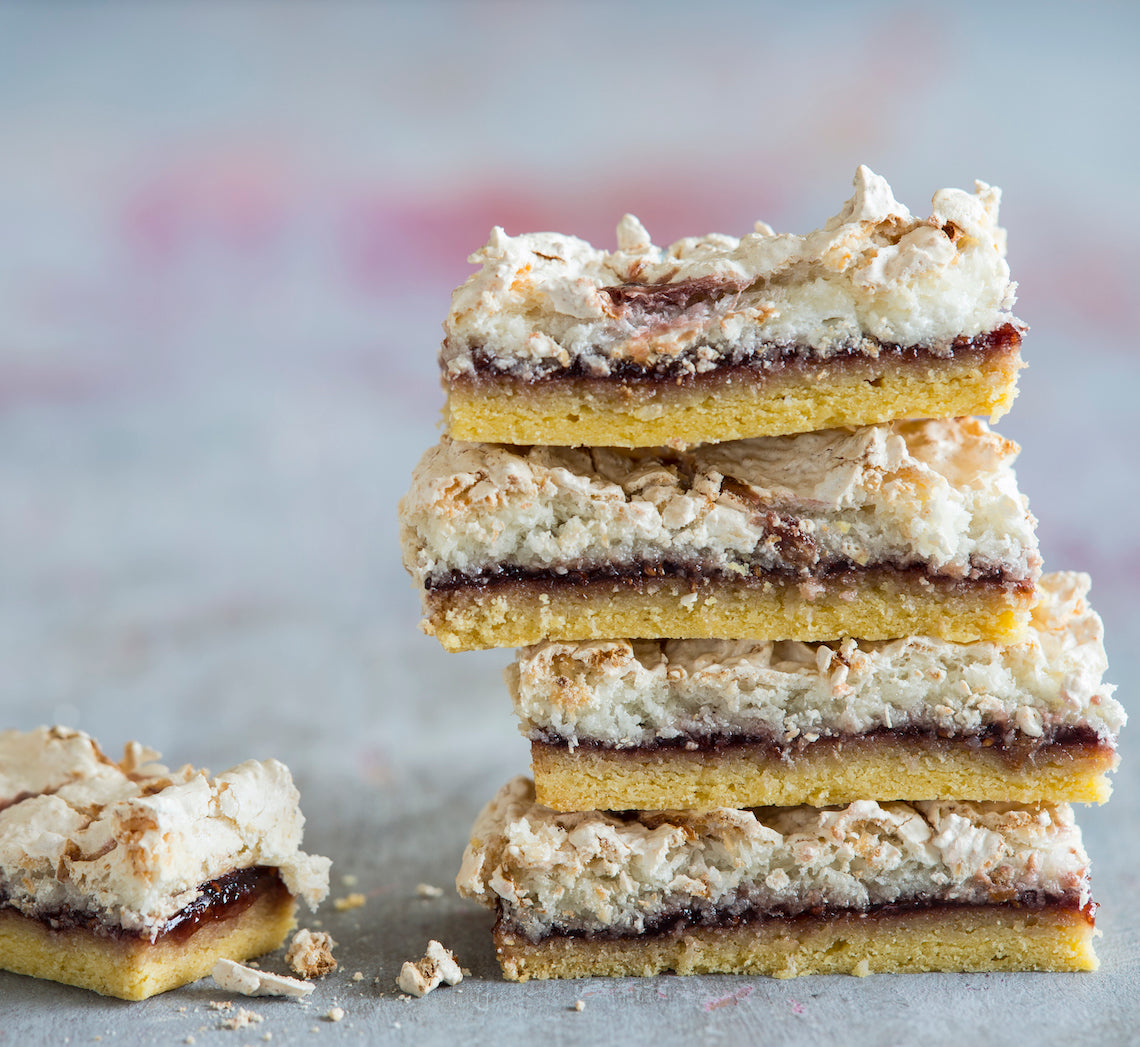
Prep 25min (+1hr cooling time)Bake 40minMakes 16 serves
More a slice than a cake, I can’t believe I have only just discovered this gem from the land of the long white cloud. I can completely understand why it features fondly in the childhood memories for anyone who grew up in rural New Zealand!
Ingredients
Melted butter, to grease
Biscuit Base
100g (3½oz) salted butter, at room temperature
110g (½ cup/4oz) caster sugar
1 teaspoon natural vanilla essence or extract
3 egg yolks
225g (1½ cups/8oz) plain flour
1 teaspoon baking powder
320g (1 cup/11¼oz) good-quality raspberry jam
Coconut Meringue Topping
4 egg whites, at room temperature
220g (1 cup/7¾oz) caster sugar
1 teaspoon natural vanilla extract or essence
135g (1½ cups/4¾oz) desiccated coconut
1 tablespoon good-quality raspberry jam (see Baker's Tips)
Method
- Preheat oven to 180°C/350°F (160°C/215°F fan-forced). Grease a 20cm x 30cm (8inx12in) slice tin with melted butter to grease and line the base and sides with one piece of non-stick baking paper, cutting into the corners to fit and allowing the paper to overhang the sides.
- To make the Biscuit Base, use an electric mixer fitted with a paddle beater to beat the butter, sugar and vanilla until pale and creamy. Beat in the egg yolks until well combined. Sift together the flour and baking powder, add to the butter mixture and beat on low speed until just combined.
- Press the biscuit base mixture into the prepared tin to cover evenly. Bake for 10 minutes or until starting to colour (the base won’t be cooked through at this stage). Remove from the oven and spread evenly with the raspberry jam. Set aside to cool slightly.
- Meanwhile, use an electric mixer with a whisk attachment to whisk the egg whites in a large clean, dry mixing bowl on medium-high speed until soft peaks form. Add the sugar, a spoonful at a time, whisking well on medium-high speed after each addition. Continue to whisk until the mixture is thick and glossy, the sugar has dissolved and a trailing peak forms when the whisk is lifted. Whisk in the vanilla and then use a spatula or large metal spoon to fold in the coconut until evenly combined. Spread the meringue mixture over the raspberry jam to cover. Dot the 1 tablespoon of jam over the top of the meringue and then use a tooth pick or skewer to swirl it through the meringue mixture.
- Return the slice to the oven and bake for 30 minutes or until golden and crisp to touch on top. Place on a wire rack and allow the slice to cool in the tin (about 1 hour).
- Use the paper to transfer the slice from the tin to a cutting board. Cut into portions to serve.
Baker's Tips
- Although raspberry jam is traditionally used in this slice, any berry jam can be used - mixed berry, strawberry and blackberry all work well.
- This slice will keep in an airtight container at room temperature in a cool spot for up to 4 days.
This recipe is from Anneka's SBS Food online column Bakeproof: Meringue. Click here for more Bakeproof columns and recipes.
Photography by Alan Benson.
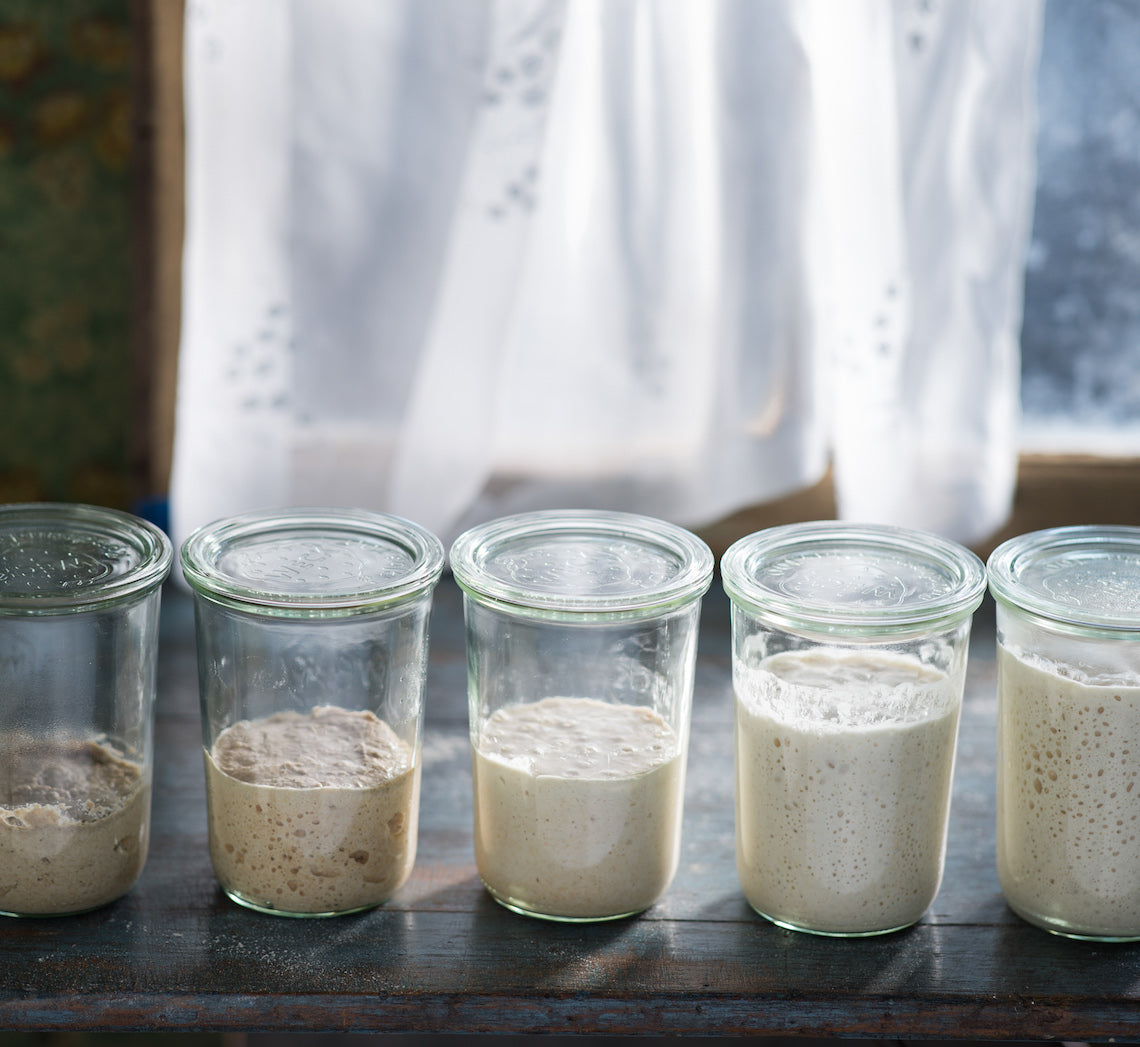
Prep 5 days
A practical, step-by-step guide with tips, tricks and timelines to making your own sourdough starter and baking with it.
This method is logical and simplified for beginner bakers to follow (and expert bakers to hone). While the process of making this starter is a little lengthy (at least 5 days) it isn’t difficult, if you follow the steps and take note of my tips.
The detailed steps are below, but here is a nifty quick reference to keep you on track:
Day 0
125g flour + 125g water, stand for 48 hours
↓ ↓
Day 2
1st feeding: 125g starter + 125g flour + 125g water, stand for 24 hours
↓ ↓
Day 3
2nd feeding: 125g starter + 125g flour + 125g water, stand for 24 hours
↓ ↓
Day 4
3rd feeding: 125g starter + 125g flour + 125g water, stand until doubled in size (8—24 hours)
↓ ↓
Day 5
If not doubled in size, feed every 12 hours until doubled in 8 hours or less
↓ ↓
Use 'active' starter OR store at room temperature or in fridge.
Sourdough starter method - Day 0
A young starter is quite sensitive so when establishing your sourdough starter it is important to follow the process (measuring the flour and water accurately, feeding at the suggested times, etc.) But once mature and strong, it will have more flexibility and will be more resilient to changes so don’t worry too much if you occasionally miss a feeding by a day or so or if your quantities are slightly out - just get back on track as soon as you can and your starter will bounce back.
Ingredients
Starter
125g organic wholemeal flour (see Baker’s Tips #1 and Variations)
125g bottled water, at room temperature (see Baker’s Tips #2 and #3)
To feed the starter
unbleached organic plain flour (see Baker’s Tips #1)
bottled water, at room temperature
Method
Day 0
- Place the wholemeal flour and water in a medium bowl and stir until well combined.
- Weigh a clean, dry jar with a lid that you are going to store your sourdough starter in and note the weight down (see Baker’s Tips #4).
- Transfer the flour mixture to the jar, seal and set aside in a warm draught-free place (see Baker’s Tips #5) for 48 hours (see Baker’s Tips #6).
After 12 hours (see images, jar 1, from left), there won’t be much change in your mixture although a few bubbles may start to appear through the side of the jar.
After 48 hours (see images, jar 2, from left), the starter may have risen just a little and a dark skin would have formed. There may be a few bubbles on the surface and also noticeable through the side of the jar – but not always. Proceed to the first feeding.
If you don't see these signs, set aside for another 24 hours – if there are no signs of activity by then, just continue with the first feeding. The aroma will be quite unpleasant.
Variations
Rye sourdough starter: replace the wholemeal flour with 100g rye flour (and feed with unbleached organic plain flour).White sourdough starter: replace the wholemeal flour with 125g unbleached plain flour (and feed with unbleached organic plain flour).
Baker's Tips
#1. In my experience, I’ve had the best results with starting a sourdough starter with organic wholemeal flour and then switching to unbleached organic plain flour for feeding until it is established. Once mature, you can then just switch to regular plain flour or bread flour for feeding, or even occasionally feed it with wholemeal flour again to add a little ‘nuttiness’ to its flavour.
#2. Use bottled water (or water that is filtered and has been allowed to stand uncovered for at least 4 hours for the chlorine to dissipate) to give your sourdough starter the best possible chance of success.
#3. It’s a good idea to embrace measuring both your flour and water in grams when making and maintaining your sourdough starter. It is the most accurate way of measuring and will give you the best possible chance of success.
#4. A sourdough starter can be mixed and kept in a non-reactive container such as a glass jar. Look for one that has straight sides and a reasonable sized mouth to make mixing easy. This starter recipe will need a jar that has a capacity of at least 1 litre (4 cups) and, before making your starter, ensure that it is very clean and dry. It’s a good idea to note the weight of your jar so that it is easy to calculate how much sourdough starter you need to remove and discard every time you feed it.
#5. The ideal temperature for proving sourdough starter is between 21°C-23.5°C (70ºF-74ºF). Don’t be tempted to keep the starter at higher temperatures to accelerate the process as it won’t necessarily mean you will get a better result. Higher temperatures can encourage more ‘bad’ bacteria to grow than the ‘good’ ones, which will ultimately ruin the starter. If your kitchen is cold, I find placing it under the stove rangehood with the light on or on top of the fridge gives a warm (but not too warm), consistent temperature.
#6. After each feeding, it’s a good idea to mark the side of the jar with tape (or an elastic band) so you can see how much it grows in the specified time.
Sourdough starter method - Day 2
First feeding after 48 hours
- Remove and discard all but 125g of the sourdough starter from the jar.
- Add 125g plain flour and 125g water to the jar and stir well to combine.
- Use a clean spatula to scrape the sides of the jar down to clean (see Baker’s Tips #7).
- Seal the jar and set aside in a warm, draught-free place for 24 hours.
After the first feeding and rise, the starter would have risen slightly (up to 50%) (see images, jar 3, from left) and random bubbles will be visible on the surface as well as through the side of the jar indicating the wild yeast is active and starting the multiply.
Baker's Tips
#7. Make sure you scrape down the side of the jar after every feed – this will make it easier to see how much the starter has risen each time.
Sourdough starter method - Day 3
Second feeding after 24 hours
- Remove and discard all but 125g of the sourdough starter from the jar.
- Add 125g plain flour and 125g water to the jar and stir well to combine.
- Use a clean spatula to scrape the sides of the jar down to clean.
- Seal the jar and set aside in a warm, draught-free place for 24 hours.
After the second feeding and rise there will be more visible bubbles but they will be smaller and more uniform (see images, jar 4, from left). The aroma will be less pungent and a little sweeter.
Sourdough starter method - Day 4
Third feeding after 24 hours
- Remove and discard all but 125g of the sourdough starter from the jar.
- Add 125 g plain flour and 125g water to the jar and stir well to combine.
- Use a clean spatula to scrape the sides of the jar down to clean.
- Seal the jar and set aside in a warm, draught-free place until doubled in size (8-24 hours, depending on the strength of your sourdough).
Sourdough starter method - Day 5
Depending on the strength of your sourdough and how quickly it ferments it may double in size in less than 24 hours. You may also notice that once it doubles it starts to lose volume and falls back on itself indicating that it needs regular feeding from this point.
If your starter has not doubled in 24 hours or less, continue the discarding and feeding process every 12 hours until it has the ability to double in size in 8 hours or less. When it does, it is now "active" and ready to use, or store in the fridge to be used at a later date (see Baker’s Tips #8).
Baker's Tips
#8. A young starter is quite sensitive so when establishing your sourdough starter it is important to follow the process (measuring the flour and water accurately, feeding at the suggested times, etc.) But once mature and strong, it will have more flexibility and will be more resilient to changes so don’t worry too much if you occasionally miss a feeding by a day or so or if your quantities are slightly out - just get back on track as soon as you can and your starter will bounce back.
What's that smell? Aroma changes in sourdough starter
When making and establishing a sourdough starter you will notice that the aromas it gives off change quite considerably from one day to the next. This is because the bacteria present is changing and ‘settling’.
To start, in the first day or so, it can smell quite foul but will mellow with subsequent feedings and over time the smell will become slightly tangy and sweet and then more sour. You will also notice once the sourdough starter has matured and is more stable, the aroma will become more consistent too.
The aroma will also change depending on where it is in the feeding cycle once established, mature and healthy; it will have a slightly sweet scent when first fed, and will become more sour as it stands and ripens ready for use.
Sourdough starters can be unpredictable
Remember all sourdough starters are different. There are so many things that can vary while making a sourdough starter (including the type of wild yeast and bacteria present, the temperature the starter is held at, etc.) and ultimately this will affect how long it takes for your starter to become mature.
Sometimes, a starter may seem to be on the right track and then, for whatever reason, it doesn’t progress at all. If yours doesn’t reflect the exact description above, don’t lose heart, be patient and keep repeating the feeding process every 12 hours until your starter reflects the Day 5 description before you move onto maintaining, storing and using it.
How to use your sourdough starter in your baking
To make sure your sourdough starter is strong and 'active' enough to use in baking, you will need to feed, maintain and store it. Click here to find out how.
Once your starter is ready to use, this Basic sourdough bread recipe is a well-tested recipe to begin your sourdough baking.
This recipe is part of Anneka's SBS Food Bakeproof: Sourdough online column. For more Bakeproof columns and recipes, click here.
Photography by Alan Benson.







